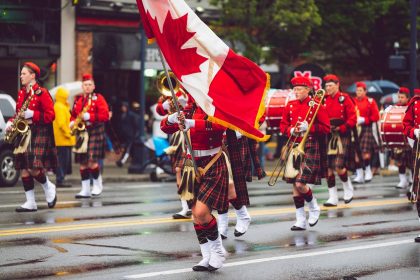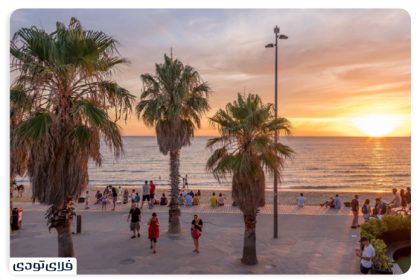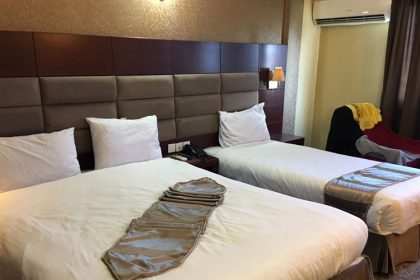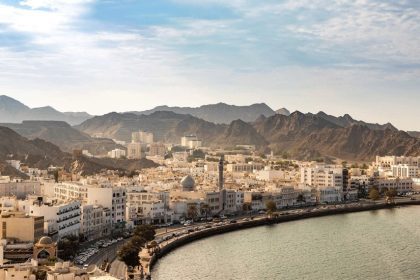The city of Rome is the most populous, the largest city and the capital of Italy, which also houses the Vatican. Rome’s tourist attractions attract millions of people from all over the world every year. To have a good and memorable trip, you should travel with a Rome tour at the right time, which is the best time between April to June (April to June) and mid-September to October (September to October). In this period of time, the air temperature is very pleasant and suitable. To have a memorable trip to this Italian city, you can go with Venk Star.
Colosseum
As the Eiffel Tower is a symbol of Paris, the silhouette of the Colosseum amphitheater is also an undisputed symbol of Italy and one of the most famous tourist attractions in Rome. The largest structure that remains from ancient Rome! The Colosseum still inspires many stadiums today. Undoubtedly, the design of today’s football stadium and its oval shape originates from the Colosseum of the ancient world.
The project of this building was started by Vespasian in 72 AD and after his son Titus expanded it by adding a fourth floor, it was opened in 80 AD with the presence of soldiers in a grand ceremony. The Colosseum was large enough to host the emperors and high-ranking officials of the time for theatrical performances, festivals, circuses or games.
St. Peter’s Church
St. Peter’s Basilica or “Basilica di San Pietro in Vaticano” is the spiritual center of the Catholic Church and the residence of the Pope. Located in the independent state of Vatican City and adjacent to St. Peter’s Square, this massive church was built on what is believed to be Peter’s tomb. St. Peter’s Basilica contains masterpieces such as Bernini’s baldachin and Michelangelo’s La Pieta, but you can also visit the crypts with 148 papal tombs. Plan your visit to St. Peter’s well in advance, otherwise you’ll probably end up standing in line for a long time. Saint Peter’s Church is one of the most famous tourist attractions in Rome.
Important note: To know the price of Europe tour and travel to Italy, you can contact our colleagues in the foreign tours unit.
Pantheon temple
The Pantheon, the best-preserved monument of Roman antiquity, has remained remarkably intact for 2,000 years and is now one of Rome’s most special tourist attractions. Meanwhile, Pope Gregory III removed the gilded bronze tiles from the ceiling, and Pope Urban VIII ordered the bronze roof to be torn down and melted down to cover the altar in St. Peter’s and the cannons in Castel Sant’Angelo.
The Pantheon was rebuilt after fire damage in 80 AD, and the resulting brickwork reflects the extraordinary technical mastery of Roman architects. Its 43-meter dome, the greatest achievement of Roman interior architecture, hangs in suspension without visible supports. The 9-meter central opening of the temple is the only source of light in the building.
Although the first Christian emperors forbade the use of this pagan temple for worship, in 609 Pope Boniface IV dedicated it to the Virgin Mary and all the Christian martyrs, and from then on, it became the burial place of the kings of Italy. Victor Emmanuel II is in the second temple (alcove on the right) and other famous Italians, including the painter Raphael, are buried in this temple.
The Troy fountain is one of the most popular tourist attractions in Rome
One of the most popular tourist attractions in Rome is this 17th century masterpiece that has been immortalized in Hollywood movies to the point where visiting it has almost become a must-do for a trip to Italy and Rome. Throwing a coin into the fountain of Troy is a tradition that is supposed to guarantee your return to Rome.
Rome’s largest fountain, the Fontana di Troye is supplied by an aqueduct originally built by Agrippa, a great patron of the arts in the first century BC, to bring water to his baths. This fountain was built for Pope Clement XII between 1732 and 1751 by Niccolò Salvi.
This image shows the sea god Oceanus (Neptune) with horses, tritons and shells. The water flows around the statues and artificial stones and collects in a large pool that is always full of coins.
What do you think will happen to all the coins thrown in the Troy fountain? The coins are collected twice a year using long-handled brushes and donated to Caritas, the Roman Catholic charity.

Sistine Chapel One of the most prominent tourist attractions in Rome
The most prominent sightseeing place among the Vatican Museums is visiting the Sistine Chapel (Capella Sistina). This name is taken from the founder of the church, Pope Sixtus IV. The impressive ceiling of this 15th-century Sistine Chapel was painted by Michelangelo in the 16th century. This painting depicts the creation story, the great flood and other scenes. The side walls are equally beautiful with paintings from the life of Jesus by Ghirlandaio, Botticelli, Perugino, Pintorichio and others. The wall behind the alter shows Michelangelo’s painting of “The Last Judgment”. The Sistine Chapel is most famous for being the area where cardinals gather to elect a new pope. When a new pope is elected, smoke comes out of the church chimney twice. White smoke signifies the election of a new pope, while black smoke signifies that the cardinals have not yet succeeded in their mission.
Captulin Museum
The two palaces in Piazza del Campidoglio house the oldest public art collection in Europe, founded in 1471. This museum was originally dedicated to sculptures from all over the ancient world. These include the Capitoline Venus, from a 4th century BC original by Praxiteles, a 4.24m Roman equestrian statue of Marcus Aurelius, a Roman statue of a dying Gaul, and the Capitoline Wolf, an Etruscan work from the 6th century BC. be.
More “modern” sculptures include the head of Medusa by the 17th-century Baroque sculptor Gian Lorenzo Bernini. Although the Capitoline Museum is best known for its outstanding collection of classical sculptures, its Capitoline Picture Gallery displays paintings by Titian, Veronese, and Rubens, along with John Baptist Caravaggio.
Read more: Get to know the tourist attractions of Verona, Italy’s city of love
Palatine Hill
Strategically located 50 meters above the Tiber, the Palatine Hill bears evidence of the earliest days of life in Rome: stone carvings found in front of the Temple of Sibyl show human activity in the 9th century BC. Later, this place was chosen by emperors and large local aristocratic families to build their palaces and today it has become one of the most valuable tourist attractions in Rome.
The Farnese Gardens were laid out on the hill in the 16th century for Cardinal Alessandro Farnese, a pleasure park of terraces, pavilions, lawns, flower beds, trees and fountains designed as a kind of staging for gatherings.
Highlights of the Palatine Hill are the House of Livia (wife of Augustus), the Cryptoporticus, the Domus Flavia, the Domus Augustana, and most importantly, the Baths of Septimius Severus. Palatine Hill is a lovely place to visit in Rome, where a park is combined with the magnificent and impressive ruins of ancient Rome.
Important note: To find out about the conditions and obtain a Schengen tourist visa, contact our experts at the visa unit.
Borghese Gallery
One of the largest parks in Rome, Borghese Gardens has many attractions, including two museums, the most prominent of which is Villa Borghese. This gallery, which was built as a guest villa and to store Borges’ art collection, includes paintings, sculptures, mosaics and reliefs, mostly from the 15th to the 18th century, and works by Raphael, Titian, Caravaggio, Bernini, Dürer and Rubens are kept there. .
Elsewhere in the park, Villa Julia was built as the summer residence of Pope Julius III in the 16th century and houses the Etruscan Museum. All these collections are the reason why Tagallery Borghese is among the top tourist attractions in Rome.
The park has a landscaped English-style garden with walking paths and ponds where you can rent boats. You can also rent a bike or scooter to explore the park. There is a great zoo called Bioparco di Roma, with natural areas and a miniature path that connects the different parts.
Several attractions for children, including playgrounds, weekend horse rides and the occasional puppet show, make the park one of Rome’s most popular attractions for families.
One of the secrets of Burghs Garden is the replica of Shakespeare’s Globe Theater where you can watch opera performances or Shakespeare plays. The plays are always in Italian, but occasional operas are performed in English.

The old neighborhood of Trastevere is the most amazing tourist attraction in Rome
On the other side of the Tiber River and outside the most popular tourist attractions of Rome, Trastevere evokes a place similar to old Rome with its medieval paths and narrow alleys. In its old buildings you will find fragments of Roman stonework and sometimes inscriptions reminding you that this ghetto was very important for three centuries and its gates were closed and guarded at night.
Trastor today is a charming neighborhood with two prominent churches that are rarely included in tourist agendas. In the third century, before Rome’s Jewish population was drawn to this side of the river, Santa Maria in Trastevere was one of the first places where Christians could worship except in secret.
This amazing area has been renovated several times, most recently in the Baroque period, the interior of the church is decorated with patterned marble floors, a golden vaulted ceiling and exceptional medieval mosaics.
We also remind you that Trastevere is a good place to find restaurants that serve authentic Roman cuisine and are less crowded than those located in popular tourist areas.
Roman Forum
Walking through the millennia-old Forum, now in the middle of a pulsating modern city, is like stepping back two thousand years into the heart of ancient Rome. Although what is left of this center of Roman life and government shows only a small part of its original glory, standing and fallen columns, triumphal arches and the remains of its walls are still among Rome’s top tourist attractions and impress visitors. , especially when you consider that the place where you are standing has been the history of the Roman Empire and the Western World for centuries.
Roman political and religious life was centered here, along with courts, markets, and meeting places. After the 7th century, the buildings were destroyed and churches and castles were built among the ancient remains.
The highlights of the Roman Forum are the Temple of Antoninus Pius, the Temple of Castor and Pollux, the Temple of Saturn, the Arch of Septimus Severus, the Curia, the Temple of Vesta, and the Arch of Titus.
Arch of Constantine
Next to the Colosseum is the Arch of Constantine, a triumphal arch built by the Senate to honor the emperor as the “liberator of the city and bringer of peace” after his victory at the Battle of Milvin Bridge in 312. This Talaq is also unique in its kind and has aroused admirers of architecture and history.
If you are planning to visit the Colosseum complex and the Arch of Constantine, and for an unforgettable experience, especially in the heat of mid-summer, visit the Colosseum on a special night tour. Not only is the complex cooler then, but the monument with its interior will be bathed in golden light and will be very magical.
Centro Storico and the Spanish Steps
Take a look at a tourist map of Rome and you’ll see an area with so many sights that it’s hard to read the street names. This historic center of Rome is full of old buildings with art-filled churches, magnificent palaces and lively squares where you can spend your entire holiday walking its ancient streets and lanes.
Most of Rome’s tourist attractions, such as Piazza Navona, the Trevi Fountain, and the Church of Santa Maria Maggiore, or lesser-known churches such as Santa Maria del Popolo, are located in this area.
But here we want to talk about the Spanish Steps. Climbing these steps leads to the French church of Trinità dei Monti. The steps take their name from the Piazza di Spagna, the square at their base, one of the most typical squares in Rome. These stairs have long been a favorite place for tourists.
The boat-shaped fountain at the foot of the Spanish Steps is known as Barcaccia and was built by Pietro Bernini, father of the great Baroque architect Gian Lorenzo Bernini.
Via Condotti, leading southwest from Piazza di Spagna, is Rome’s most fashionable shopping street, where Cafe Greco became famous for the artists, writers, and musicians who frequented it.

Via del Corso, Rome’s shopping street
Via del Corso is the main street in Rome that runs in a straight line from Piazza Venezia to Piazza del Popolo. Rows of shops and restaurants and several palaces with art museums, including the magnificent Palazzo Doria Pamphilj, line this magnificent street.
While most of the shops on Avenida del Corso are made up of famous global brands, some local and small boutiques can also be found there.
Between Piazza del Popolo at the end of Via del Corso and Piazza di Spagna, look for antique shops and art galleries on Via del Babuino.
Doria Famji collection is one of the most beautiful tourist attractions in Rome
The best of Rome’s private art collections are displayed in the magnificent Baroque galleries, state rooms and chapel of the Palazzo Doria Pamphilj. Representing the works of European masters from the 15th to the 18th century, these collections include paintings by Filippo Lippi, Bruegel the Elder, Corgio and Raphael, along with important works by Caravaggio (The Serenity on the Flight into Egypt) and Titian (Salome with the Head of John the Baptist). .
Velázquez’s portrait of Innocent X is one of the highlights of the collection. The palace itself, with its painted ceilings and baroque decorations, shines almost more than its contents. A good audio guide in English is provided to tourists.
Read more: The most delicious Italian dishes The most famous dishes in Europe
Navona Square is one of the oldest tourist attractions in Rome
One of Rome’s most characteristic Baroque squares, Piazza Navona still has the outline of the Roman stadium built here by Emperor Domitian. This place was used for festivals and horse races in the Middle Ages and later “Borromini” rebuilt Navona in baroque style and designed a magnificent complex of palaces and Sant’Agnese church on its western side.
The facade and dome of the nave highlight the way Baroque architecture weaves convex and concave surfaces, gables, windows, columns and plinths into a unified design. In the crypt of St. Agnes, there is the Miracle of St. Agnes by Alessandro Algardi in 1653 and the remains of a Roman mosaic floor. St. Agnes provided the model for Baroque and Rococo churches in Italy and elsewhere.
Although Borromini designed the piazza and its surrounding facades, his main rival was Bernini, who created its centerpiece, the beautiful Baroque fountain, Fontana di Fiumi. This spirit-giving fountain represents four rivers, which at the time were thought to be the largest known rivers on any of the continents.
Two other fountains in the square are the 16th-century Fontana del Moro in front of the Palazzo Pamphili, built by Giacomo della Porta. Today, this square is one of the most famous tourist attractions in Rome and is full of Romans, tourists, street artists, musicians, souvenir kiosks, cafes and in December, one of the best Christmas markets in Rome.
Del Popolo Square
Piazza del Popolo, symmetrically located at the apex of a triangle of streets containing Via Corso, Rome’s main shopping street, was designed in the early 19th century as the northern entrance to the city center. In its center, the Egyptian obelisk named Flaminio is located above a fountain where four white marble lions pour water into four round travertine basins.
On either side of Via della Corso are the twin churches of Santa Maria di Miracoli and Santa Maria di Montesanto, and on the opposite side of the great square, the Augustinian church of Santa Maria del Popolo can be seen.
Inside the Chiesa del Popolo, you will find frescoes by Pinturicchio and two tombs of Andrea Sansvino in the choir and two beautiful chapels. The Chigi Chapel was designed by Raphael in 1515 and the Cesari Chapel houses two important paintings by Caravaggio.

The National Museum of Saint Angelo Palace is one of the most famous tourist attractions in Rome
Built in 135 AD as the tomb of Emperor Hadrian and his family, Castel Sant’Angelo is a massive drum-shaped structure overlooking the Tiber near the Vatican. Castel Sant’Angelo has been used as a papal residence, a fortress, and more recently as a national museum over the millennia.
In 271 AD, Emperor Aurelian took advantage of its position to protect the city’s northern approaches and incorporated it into his new system of walls around the city. As a bastion, the castle protected the city from barbarian attacks and became a significant fortress in the Middle Ages. In times of danger, the popes fled here through an elevated passageway called the Passetto di Borgo and stored their most precious wealth in the castle’s treasury.
Visitors reach the castle via a footbridge lined with angel statues (by Bernini) and ascend a spiral ramp of five. On the different levels of the castle are prison cells, a large collection of weapons, and lavishly decorated papal apartments covered in Renaissance frescoes. At the top of the building there is a terrace with stunning views of the city.
The country and the Vatican Church
With an area of less than half a square kilometer, the Vatican is the smallest independent country in the world, most of which is enclosed by the walls of the Vatican.
The Vatican Palace and Gardens, St. Peter’s Basilica, and St. Peter’s Square, the area ruled by the Pope, the supreme head of the Roman Catholic Church, are located within this small country. Between its museums and the cathedral itself, this compact space offers plenty to see.
Inside St. Peter’s Basilica is Michelangelo’s masterpiece, the Pieta, along with sculptures and altarpieces by Bernini and others.
The undisputed highlight of the Vatican Museums is the Sistine Chapel, whose magnificent painted ceiling is Michelangelo’s most famous work.
Raphael’s rooms are located in the Vatican Palace. The Borgia Apartments, the Vatican Library and a number of museums, including the Picture Gallery, the Secular Art Museum, the Etruscan Museum, etc., are among the other sights of the Vatican and Rome’s tourist attractions. The collections you can see here range from pop teachers to 20th century art that reflects religious themes.
The queues for tickets to the Vatican attractions are extremely long and you have to wait in line for several hours. To save time, purchase a Skip the Line: Vatican Museums Tour with St. Peter’s, Sistine Chapel and Small Group Upgrade in advance. This three-hour tour allows you to skip the long lines and enter the museums directly with an experienced guide.

final word
In a city filled with symbols of antiquity and the Christian faith, it’s hard to know where to go first. Of course, it is primarily the preferences that determine the priorities, but among the tourist attractions of Rome there are certain places that are almost the most important symbols of Italy and the top attractions of the world, such as the Colosseum and the Pantheon! In this article, we got acquainted with these unique sights. So, if you are planning to travel to Rome, you can easily plan a tour of this beautiful city.
Copying of the contents of Setare Vanak Airline Agency is prohibited only by mentioning the source.
RCO NEWS
















